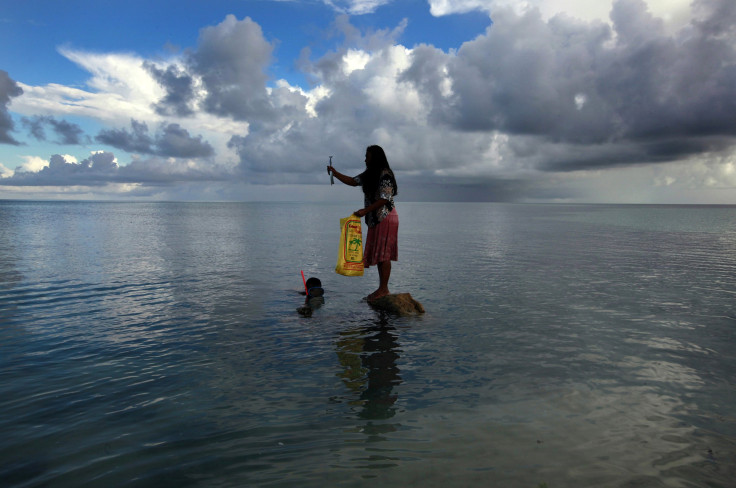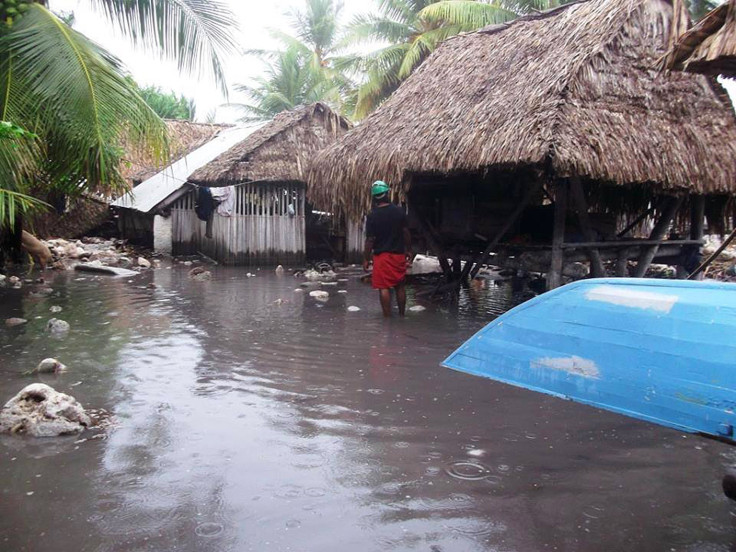Kiribati Climate Change Relocation Refugee Crisis? Sinking Low-Lying Island Nations In Pacific, Indian Oceans Seeking Solutions Before It's Too Late

Even though battling climate change was added as one of the new sustainable-development goals during the recent session of the United Nations General Assembly, the organization’s definition of a refugee has remained focused on people escaping persecution, excluding climate change as a factor. But sea levels have continued to rise around the globe -- a phenomenon scientists have attributed in part to climate change -- and representatives of several low-lying island countries in the Pacific and Indian oceans, including Kiribati, have been meeting this weekend to discuss options for relocating their populations and finding the financial resources to do it.
While conflict and wars in the Middle East and North Africa have largely driven the current refugee crisis in Europe, experts have indicated a burgeoning global migration movement could be in play with coastal cities and countries especially susceptible to the effects of climate change.
“It’s only set to get worse,” said Maxine Burkett, an associate professor of law who focuses on climate change at the University of Hawaii at Manoa’s William S. Richardson School of Law. She said the compounded effect of all factors were important. “In the next generation or two, it’s possible the majority of the island [of Kiribati] will have to be evacuated.”
Estimates have indicated that between 665,000 and 1.7 million people in the Pacific alone could be displaced or forced to migrate by 2050 because of the effects of climate change associated with rising sea levels. These levels could rise by as much as 16 inches from 1990 to 2090, according to estimates on the high end. Forecasts of this nature have led experts to warn that the island countries of Kiribati, located in the central Pacific about 2,500 miles southwest of Hawaii, and the Maldives, in the Indian Ocean, could disappear within the next 30 to 60 years. And the nation of Tuvalu, sited midway between Australia and Hawaii, could be gone in the next 50 years.
Before the meeting where leaders were scheduled to discuss how and where to move climate-change migrants in a dignified way, the foreign minister of the Marshall Islands linked climate change with genocide. “Displacement of populations and destruction of cultural language and tradition is equivalent in our minds to genocide,” Tony de Brum said this week. “People must know that climate change can be reversed if we do it now.”
Leaders of states such as Kiribati and Tuvalu have been critical of the great emissions of greenhouse gases that have contributed to the melting of polar ice caps and the rise of sea levels that threaten their islands. During the next 30 to 60 years, some of the atolls in their countries could be submerged completely underwater or become uninhabitable because of salination and the related property damage.
This threat could ultimately make Kiribati the world’s newest former state. As a precaution, Kiribati, with a population of in excess of 100,000, has already bought land on Fiji more than 1,000 miles away at a cost of over $8 million.
“We would hope not to put everyone on one piece of land, but if it became absolutely necessary, yes, we could do it ... It’s basically going to be a matter of survival,” Kiribati’s President Anote Tong told the Associated Press last year.
Even Fiji has been forced to move its own citizens from low-lying areas. The cost of relocating three villages was about $2 million. But with an estimated 45 other communities likely to need resettling in the next 10 years, the government doesn’t have sufficient funds to continue such making such moves, the South Pacific island nation recently warned.
The Maldives has constructed an artificial island and created a sovereign wealth fund that could be used to buy land elsewhere.
In contrast, Tuvalu, with a population of a little more than 10,000, has left the decision about whether to migrate to its citizens, with some of them taking advantage of an agreement with New Zealand that allows 75 people to emigrate there every year. “The government doesn’t push people to leave, and it doesn’t have any plans for migration for climate change. Our policy is to save Tuvalu,” said Aunese Makoi Simati, Tuvalu’s permanent representative to the U.N. He noted that the Tuvaluan community has grown in New Zealand in recent years with older migrants offering jobs to newer ones as part of the arrangement between the two governments. There are now several thousand Tuvaluans in New Zealand.

A comparison between the millions of people who fled their homes because of the Syrian Civil War and those doing likewise in the expected, eventual exodus of natives of low-lying nations due to climate change is well-founded, according to one migration expert.
“We use the language of migrants and refugees to capture what is happening in Europe,” said Saskia Sassen, a professor of sociology at Columbia University in New York. “But what we see in Europe is the most extreme form of a much larger trend that we can describe overall as a loss of habitat.”
In addition to increasing sea levels, islands in the Pacific and Indian oceans are now faced with a lack of arable land because of the salination of soil. Big cyclones and typhoons have also wreaked havoc in recent years.
“The big question: Who, then, is responsible for the people and for the small island states that are most severely affected?” asked Kathleen Newland, a co-founder and senior fellow at the Migration Policy Institute, a think tank based in Washington. “Relocation seems to be the only possibility.”
Newland argued that now is the time to set up standard operating procedures in larger states, especially the comparatively nearby countries of Australia and New Zealand, which could eventually have to take in climate-change refugees. A citizen of Kiribati who applied to be a climate-change refugee in New Zealand was denied asylum in September, with a court saying his request did not measure up to the standard of “serious harm” required of applicants for refugee status.
Climate change has posed a major challenge to international governance. “Can you still maintain your statehood?” the Richardson School of Law’s Burkett asked. “We may have to contemplate the definition of a state,” with the world potentially seeing governments without sovereign territory in coming decades.
Global climate-change talks have been scheduled in Paris for December, with the aim of agreeing on keeping global warming below 2 degrees Celsius. Tuvalu has pushed for a goal of 1.5 degrees.
Now is the time to discuss coordination and plan for what could be the next refugee crisis, said Simati, the Tuvalu permanent representative to the U.N. who has already witnessed small islets disappearing in his native country. He hopes global leaders will commit to an ambitious target in Paris.
“In the future, if we don’t address climate change, other kinds of migrants will join the influx to other more-developed countries,” Simati said, referring to the current situation in Europe.
© Copyright IBTimes 2025. All rights reserved.






















